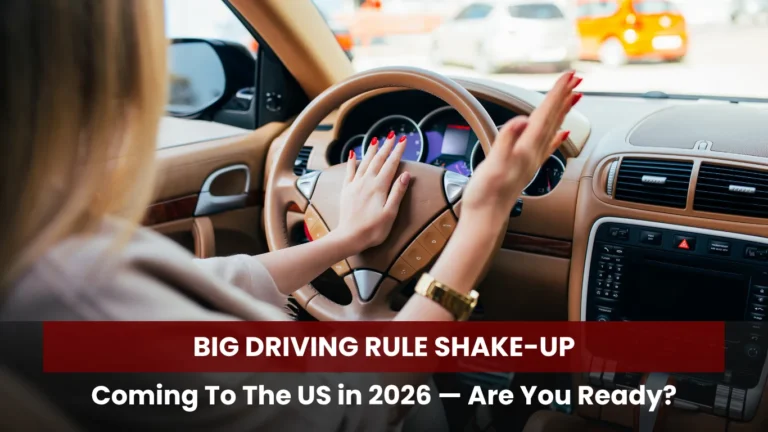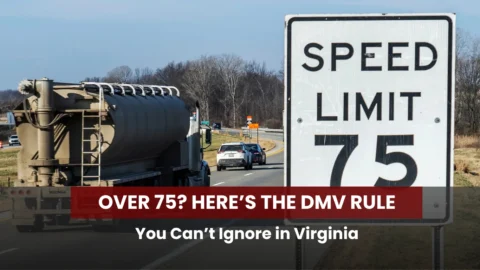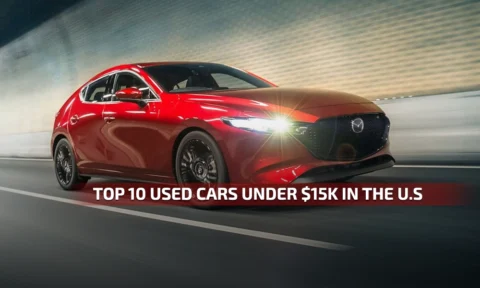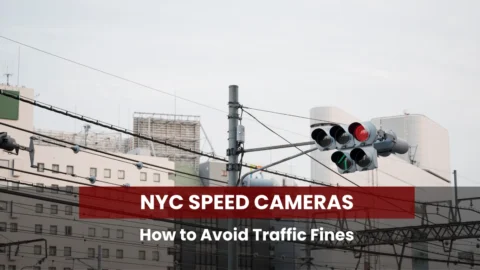I was chatting with a friend last week who told me he’s seriously reconsidering buying a new car now because of sweeping changes expected in US driving laws 2026. From federal mandates to shifting DMV rules, 2026 may usher in one of the most significant updates to how we drive in decades.
In this post, I’ll break down what’s on the horizon, how it could affect you, and how to prepare.
What’s Driving the 2026 Rule Overhaul?
Many of these shifts stem from the Infrastructure Investment and Jobs Act, passed in 2021. Among its many provisions is a requirement that the National Highway Traffic Safety Administration (NHTSA) develop standards for drunk or impaired driving detection technology in new cars.
That’s right, by 2026 (or model year 2026), new driving rules 2026 could require vehicles to incorporate systems that detect impairment and prevent operation if the driver is intoxicated.
To put it plainly, if you thought the “kill switch” or passive alcohol detection were only ideas propagated by sci-fi novels and films, you’ll be shocked to know that it’s likely to become part of car regulations 2026 in the USA. Some media and legal blogs have already started referring to this proposed requirement as a mandatory “kill switch” embedded in new vehicles.
Simultaneously, NHTSA is updating safety test protocols. Starting with the 2026 model year, crash safety ratings will include driver-assistance features like blind-spot warnings, pedestrian automatic emergency braking, lane-keeping assist, and blind-spot intervention. This pushes automakers to adopt tech that supports road safety even before government mandates kick in.
All of these point to a broader shift. Road safety laws in the USA for 2026 won’t just be about enforcement and penalties, but about embedding safety and monitoring tech into the vehicles themselves.
What Driving Test Changes Are Likely in the USA in 2026?
While the federal directives focus mostly on vehicle tech, states and DMVs will likely follow with regulatory tweaks around licensing, enforcement, and inspections. Here’s what could change:
- Driver’s License Changes & Testing Protocols
Expect US driver’s license changes aimed at impairment awareness, perhaps mandatory education about the new tech. Some states may introduce impairment detection as part of the licensing exam or require demonstrations of safe driving with driver-assist features.
- Compulsory Inspections in 2026
State DMVs could mandate inspections to ensure these new systems function properly. Cars may fail inspections if the impairment detection module or related sensors are malfunctioning, much like how emissions are enforced now.
- Possible New State Road Rules 2026
States might adopt complementary rules like banning override of impairment systems, setting thresholds for intervention, or ensuring that drivers can’t bypass safety functions. There could also be variations in how enforcement works (ticketing, warnings, or automatic disablement) depending on jurisdiction.
- New Car Regulations For Automakers in 2026
Automakers will face tougher standards for how these systems are integrated into their vehicles, including requirements on false-positive rates, override mechanisms, and privacy protection. The regulatory burden may shift costs to buyers or be absorbed by manufacturers, depending on scale and policy design.
- US Traffic Law Changes & Penalties in 2026
The fact that you are likely to have system-detected impairment might lead to new legal definitions of violations, where drivers could be penalized based on sensor outputs from their own vehicles. This would blur the line between tech-based enforcement and traditional police authority.
- New Driving Rules 2026 Beyond Impairment Detection
As I noted, safety rating changes (blind-spot, pedestrian detection) are also part of the changes expected in 2026. Vehicles will likely need those systems as standard or risk poor safety ratings that will influence consumer choices.
How This Will Impact Drivers & Buyers
When to buy a new car?
If you buy just before the rule goes active, you might choose a car without the new tech but might miss out on vehicles with safer features or better compliance value.
Cost implications
Embedding these systems in vehicles is bound to be expensive. Some estimates suggest the “kill switch” mandate could add $500–$2,000 per vehicle.
Tech “false positives” & override concerns
What happens if the system flags you incorrectly? Manufacturers will be forced to build override or fallback protocols. Some users already express distrust about misidentification, especially when sensors are sensitive to non-drinking ethanol sources (hand sanitizers, pollution, etc.)
Privacy & data concerns
These systems will collect behavioral and biometric data. How much of that is stored or shared? Regulations will have to balance safety with driver rights and data protection.
Resale or compliance risk
A car lacking these features might lose value or be noncompliant in certain states down the line. Buyers may prefer versions that include mandated systems. This will reduce the resale value of vehicles that do not have the technology.
Enforcement & liability
If the vehicle disables itself due to a detected impairment, whose liability is it? Manufacturer, driver, or both? Courts will likely see new litigation in product liability and wrongful disability.
Insurance effects
Vehicles with mandatory safety systems may see lower crash risk, which could encourage insurers to offer discounts or incentives, but pricing models will need to evolve.
Timeline & What to Watch
Here is a rough projection based on current legislative and regulatory signals:
| Phase | What Happens | Implications |
| 2024–2025 | Advance notices, rule drafting & public comment by NHTSA | Automakers, safety groups, and public stakeholders weigh in |
| 2025–2026 | Final rule published; lead-up compliance window | Automakers integrate systems into new models |
| Model Year 2026 Onward | New cars begin shipping with mandated systems | Early models may carry flags or limitations |
| 2027 and Beyond | States and DMVs begin enforcement, inspections, and penalties | Legacy vehicles transition period, exemptions, and grandfathering |
Because the Infrastructure Act mandated NHTSA to act by 2024, rule finalization is expected relatively soon. In parallel, organizations like the IIHS have announced that starting in 2027, impaired-driving and speed detection systems will be required for a vehicle to earn a top safety rating.
In short, by mid-2026, you’re likely to begin seeing cars on lots that refuse to start (or behave differently) if the system detects impairment.
Challenges & Issues Behind the Scenes
Technology maturity & reliability
The sensors and algorithms must be extremely accurate; false positives are not just inconvenient but could ruin lives.
Cost & market acceptance
Consumers may hesitate to pay higher prices. Trust, transparency, and testability will matter a lot for adoption.
Data privacy & regulation
Strict limits will be needed about how sensor data is stored, accessed, or shared (especially with law enforcement).
Legal & liability complexities
Disputes over system failures, disablement, or misclassification will likely generate lawsuits and set precedents.
State-by-state legal fragmentation
While the federal rule sets a baseline, states may add extra layers or opt-out conditions. Drivers in different states may face varying versions of enforcement.
Used car/legacy fleet issues
What happens to cars built before the mandate? Will retrofits be required? Likely not, but that raises questions of differential safety standards.
Are You Ready for the 2026 Driving Revolution?
Consider taking these preemptive precautions to prepare for the coming changes:
- If buying a new car in 2025–2026, ask your dealer whether it includes the new systems or if upgrades are planned.
- Track rulemakings, public comment periods, and NHTSA announcements.
- Monitor inspection / DMV changes in your state — those often follow federal mandates.
- Stay skeptical and informed about how these systems work, what data they collect, and how they affect driver sovereignty.
FAQ: New Driving Rules 2026 USA & Related Questions
The mandate seems to cover new passenger vehicles, though the precise scope (light trucks, SUVs, commercial vehicles) will be determined once rules are framed.
It’s likely to be model year 2026. Automakers will need lead time after the final rule is published. Some sources suggest full compliance starting in late 2026 or early 2027.
No. Most mandates like this apply to new vehicles. Existing cars are unlikely to be required to retrofit the systems.
Possibilities include breath-based sensors, touch-based sensors (steering wheel or start button), or camera/sensor monitoring (eye movement, driver behavior).
The rulemaking process is expected to require override or fallback modes and safety margins. But yes, that’s a key concern among commenters and critics.
Possibly. Safer cars might justify lower premiums. But that depends on insurers, accident data, and market adoption.
Federal standards will override state laws in vehicle manufacturing. But how states enforce inspections, penalties, or override laws may vary.
The federal rule will likely specify performance and interoperability standards; whether systems are mandatory vs. optional or proprietary will be clarified during rulemaking.
Final Thoughts
The shake-up to driving rules in the US in 2026 is not about a single change. It’s more of a paradigm shift. US traffic law changes are now extending into your vehicle’s internal systems, embedding safety, monitoring, and enforcement in the car itself. If you drive (or plan to), it’s not enough to read about these changes; you’ll want to proactively take steps to safeguard your interests.
For model comparisons or preparing for changing laws in your state, trust Ask About Cars for the latest updates.






